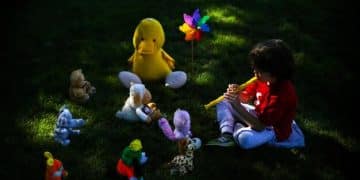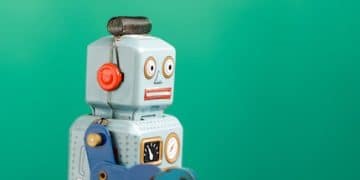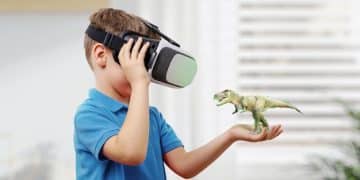STEM Toys 2025: Top Educational Toys in US Schools
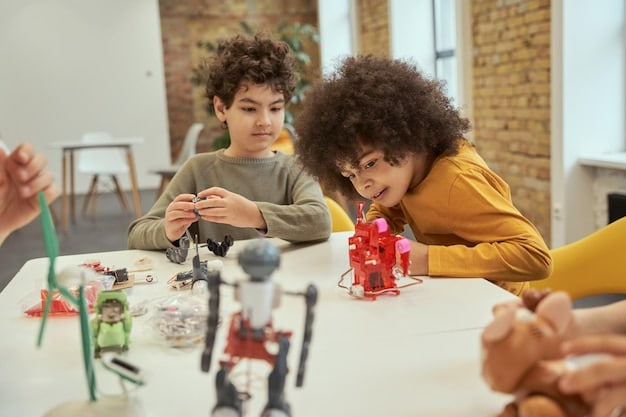
STEM toys in 2025 are evolving rapidly with increased focus on robotics, coding, and eco-friendly materials, reflecting their growing integration into US schools to enhance critical thinking and problem-solving skills among students.
Are you curious about the future of learning? STEM toys in 2025 are set to revolutionize education in US schools, blending fun with essential skills for the next generation. Let’s explore which educational toys are gaining traction and why they matter.
The Rise of STEM Education in US Schools
STEM education, encompassing Science, Technology, Engineering, and Mathematics, is becoming increasingly vital in US schools. This emphasis reflects a growing recognition of the need to equip students with the skills necessary to thrive in a rapidly evolving, technology-driven world. As such, STEM toys are not just playthings; they are valuable tools for educators seeking to foster critical thinking, problem-solving, and creativity in their classrooms.
The integration of STEM toys into curricula is driven by several factors, including the need to improve student engagement, enhance learning outcomes, and prepare students for future careers in STEM fields. These toys provide hands-on learning experiences that make abstract concepts more concrete and relatable, helping students develop a deeper understanding of the subject matter.
Why STEM Education Matters
STEM education is essential for preparing students for the challenges and opportunities of the 21st century. Here’s why:
- Economic Growth: STEM fields are driving innovation and economic growth, creating high-paying jobs and contributing to the overall prosperity of the nation.
- Global Competitiveness: The US must maintain a strong STEM workforce to remain competitive in the global economy.
- Problem-Solving Skills: STEM education equips students with the skills to solve complex problems, think critically, and make informed decisions.
- Innovation: STEM fosters innovation and creativity, leading to new technologies, products, and solutions to global challenges.
As we look to 2025, the role of STEM education in US schools will only continue to grow, with educational toys playing an increasingly significant role in shaping the future of learning.
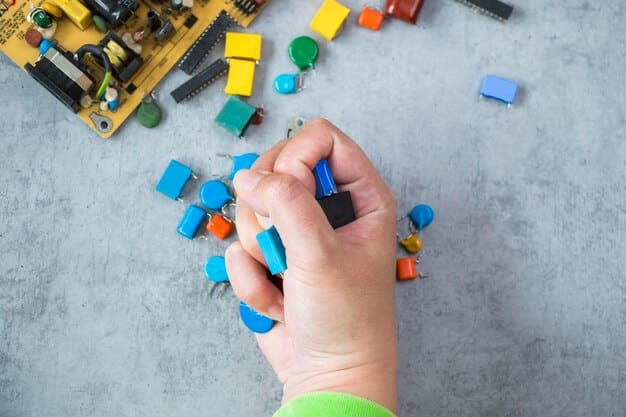
Robotics and Coding Toys: The New Frontier
Among the most popular and impactful STEM toys are those that focus on robotics and coding. These toys not only introduce students to the fundamentals of computer science and engineering but also encourage them to develop problem-solving skills, logical thinking, and creativity. Robotics and coding toys provide a hands-on, engaging way for students to learn about programming, algorithms, and mechanical design.
In 2025, robotics and coding toys are expected to become even more sophisticated and integrated into school curricula. With advancements in AI and interactive technology, these toys will offer personalized learning experiences that adapt to each student’s skill level and learning style.
Popular Robotics and Coding Toys
Here are some examples of robotics and coding toys that are gaining traction in US schools:
- Programmable Robot Kits: These kits allow students to build and program their own robots, teaching them about mechanical engineering, electronics, and coding.
- Coding Games: These games introduce students to coding concepts through fun, interactive challenges that require them to write code to solve puzzles or complete tasks.
- Robotic Animals: These toys allow children to learn about animal behavior through programming with pets.
The appeal of robotics and coding toys lies in their ability to make complex concepts accessible and engaging for students of all ages. By providing hands-on learning experiences and fostering creativity, these toys are helping to shape the next generation of innovators and problem-solvers.
Hands-On Science Kits: Experiments at Home and School
Science kits have long been a staple of STEM education, providing students with the opportunity to conduct experiments and explore scientific concepts in a hands-on way. In 2025, science kits are expected to become even more innovative and relevant, incorporating new technologies and addressing pressing global challenges. Hands-on science kits are a way kids learn science without all the fluff.
These kits cover a wide range of scientific disciplines, including chemistry, physics, biology, and environmental science. They often include all the materials and instructions needed to conduct experiments, making them accessible and convenient for both teachers and students.
Impact of Hands-On Experiments
Conducting experiments is a great way to engage kids with science. Here’s how:
- Concrete Learning: Science kits help students to engage with science topics in a way that promotes engagement and enjoyment from the learning experience.
- Problem-Solving: Many STEM experiments teach kids how to solve real-world challenges.
- Collaboration: These kits help to promote collaboration and group interaction in the classroom to work together to reach a solution.
By providing hands-on learning experiences, science kits help students develop a deeper understanding of scientific concepts and foster a lifelong love of learning.
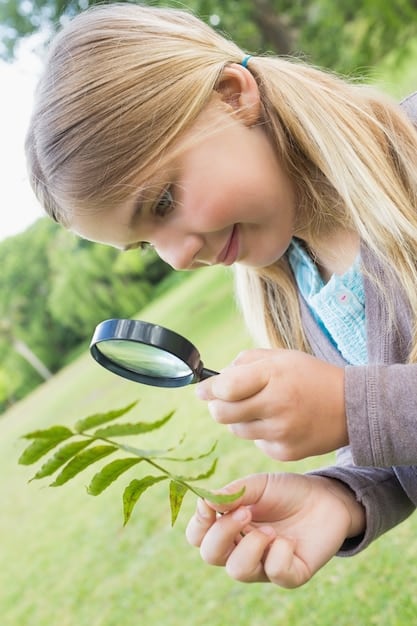
Building and Engineering Toys: Constructing the Future
Building and engineering toys are essential for developing spatial reasoning, problem-solving skills, and creativity. These toys allow children to design, construct, and test their own creations, fostering an understanding of engineering principles and encouraging innovation. As we move towards 2025, these toys will undoubtedly evolve to incorporate new technologies and sustainable materials, reflecting the changing landscape of engineering and construction. Building and engineering toys help children to build the future, one block at a time.
These toys range from simple building blocks to complex construction sets, catering to a wide range of ages and skill levels. They provide opportunities for children to explore concepts such as structural integrity, mechanics, and design, while also encouraging them to think critically and solve problems.
Benefits of Building and Engineering Toys
Building and engineering toys offer numerous benefits for children’s development:
- Spatial Reasoning: These toys help children develop spatial reasoning skills, which are essential for success in fields such as architecture, engineering, and design.
- Problem-Solving: Building and engineering toys challenge children to solve problems and think creatively, fostering resilience and adaptability.
- Creativity: These toys allow children to express their creativity and imagination, encouraging them to design and build their own unique creations.
By providing hands-on learning experiences and fostering creativity, building and engineering toys are helping to shape the next generation of architects, engineers, and innovators.
Eco-Friendly and Sustainable STEM Toys: Learning with a Conscience
As awareness of environmental issues grows, there is an increasing demand for eco-friendly and sustainable STEM toys. These toys are made from sustainable materials, such as recycled plastics, wood, and plant-based materials, and are designed to minimize their environmental impact. By choosing eco-friendly STEM toys, parents and educators can teach children about sustainability and responsible consumption while also providing them with valuable learning experiences. Eco-Friendly and Sustainable STEM Toys provide children with a conscience, as they learn while protecting the environment.
These toys often focus on environmental science and sustainability, teaching children about topics such as climate change, renewable energy, and conservation. They may include activities such as building solar-powered cars, creating miniature ecosystems, or conducting experiments to test water quality.
The Importance of Sustainable STEM Toys
Sustainable STEM toys make learning about the environment fun. Here’s how:
- Environmental Awareness: These toys raise awareness of environmental issues and inspire children to take action to protect the planet.
- Responsibility: Sustainable STEM toys teach children about responsible consumption and the importance of making sustainable choices.
- Innovation: These toys encourage innovation and creativity in the field of sustainability, inspiring children to develop new solutions to environmental challenges.
By providing hands-on learning experiences with a focus on sustainability, eco-friendly STEM toys are helping to shape the next generation of environmental stewards and innovators.
The Role of Augmented Reality (AR) and Virtual Reality (VR)
Augmented Reality (AR) and Virtual Reality (VR) technologies are poised to transform the landscape of STEM education. These immersive technologies offer unique opportunities to enhance learning experiences, making abstract concepts more concrete and engaging. In 2025, AR and VR are expected to become more integrated into STEM toys and educational resources, providing students with interactive, personalized learning experiences. Augmented Reality (AR) and Virtual Reality (VR) are poised to play a large role in how kids learn STEM.
AR overlays digital information onto the real world, allowing students to interact with virtual objects and environments in their physical surroundings. VR, on the other hand, creates fully immersive digital environments that transport students to different places and times. Both technologies can be used to simulate experiments, explore complex systems, and visualize abstract concepts.
Advantages of Augmented and Virtual Reality
AR and VR are powerful tools that will continue to grow in STEM learning. Here are some advantages:
- Engagement: AR and VR provide engaging, interactive learning experiences that capture students’ attention and motivate them to learn.
- Visualization: These technologies allow students to visualize abstract concepts and complex systems, making them easier to understand.
- Accessibility: AR and VR can make STEM education more accessible to students with disabilities or those who learn best through visual or kinesthetic methods.
By providing immersive, interactive learning experiences, AR and VR are helping to transform STEM education and prepare students for the challenges and opportunities of the future.
Preparing for the Future: Skills Developed Through STEM Toys
The ultimate goal of STEM education is to equip students with the skills they need to succeed in the 21st century. STEM toys play a crucial role in this process, fostering critical thinking, problem-solving, creativity, and collaboration. As we look to 2025, it’s clear that these skills will be more important than ever, as the world becomes increasingly complex and interconnected. Preparing for the Future is incredibly important for today’s youth, and STEM toys provide a way to help with that.
By engaging with STEM toys, students develop a deeper understanding of scientific and mathematical concepts, while also honing their ability to think critically, solve problems, and work collaboratively. These skills are essential not only for success in STEM fields but also for navigating the challenges and opportunities of everyday life.
- Collaboration: Collaboration increases creative inspiration from others and promotes better solutions.
- Problem-Solving: Finding solutions to problems is the mark of a STEM-oriented career.
- Critical Thinking: Critical thinking allows one to assess their surroundings to ensure complete and logical decision-making.
As educators and policymakers prioritize STEM education, STEM toys will continue to play a vital role in shaping the next generation of innovators, problem-solvers, and leaders.
| Key Concept | Brief Description |
|---|---|
| 🤖 Robotics & Coding | Toys teaching computer science and engineering principles. |
| 🧪 Science Kits | Hands-on experiments to explore chemistry, physics, and biology. |
| 🏗️ Building Toys | Tools to foster spatial reasoning and engineering skills. |
| 🌱 Eco-Friendly Toys | Sustainable toys that teach environmental awareness. |
FAQ
▼
STEM toys help develop essential skills such as critical thinking, problem-solving, creativity, and collaboration, which are crucial for success in the 21st century.
▼
STEM education is vital as it equips students with skills necessary for innovation, global competitiveness, and high-paying jobs in technology-driven fields.
▼
Robotics and coding toys introduce students to computer science and engineering, encouraging problem-solving and logical thinking through hands-on, engaging challenges.
▼
Eco-friendly STEM toys teach about sustainability, responsible consumption, and environmental awareness, fostering stewardship and innovation in children through sustainable materials and activities.
▼
AR and VR offer immersive learning experiences that enhance engagement and visualization of complex concepts, making STEM education more accessible and interactive for students.
Conclusion
As we approach 2025, STEM toys are set to play an even more significant role in shaping the educational landscape of US schools. By fostering critical thinking, problem-solving, and creativity, these toys are not just tools for learning; they are investments in the future of our students and our nation.

